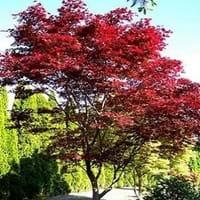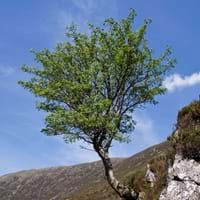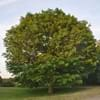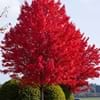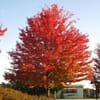Life Span
Perennial
Perennial
Origin
Eastern Asia
Asia, Europe, Northern Africa
Types
Not Available
Sorbus aucuparia fenenkiana, Sorbus aucuparia glabrata, Sorbus aucuparia praemorsa
Number of Varieties
Not Available
Habitat
Forest margins, gardens, Suburban areas, Woods
Temperate Regions
USDA Hardiness Zone
6-8
3-7
Sunset Zone
A3, 2a, 2b, 3a, 3b, 4, 5, 6, 7, 8, 9, 10, 12, 14, 15, 16, 17, 18, 19, 20, 21, 22, 23, 24
A1, A2, A3, 1a, 1b, 2a, 2b, 3a, 3b, 4, 5, 6, 7, 8, 9, 10, 14, 15, 16, 17
Habit
Oval or Rounded
Oval or Rounded
Flower Color Modifier
Bicolor
Bicolor
Fruit Color
Red, Green, Brown
Orange, Yellow
Leaf Color in Spring
Burgundy, Dark Red
Green
Leaf Color in Summer
Burgundy, Dark Red
Green
Leaf Color in Fall
Red, Burgundy, Dark Red
Dark Green
Leaf Color in Winter
Not Available
Dark Green
Leaf Shape
Maple shaped
Pinnate
Plant Season
Spring, Summer, Fall, Winter
Spring, Fall
Sunlight
Partial Sun, Partial shade
Full Sun, Partial Sun
Type of Soil
Loam, Sand
Clay, Loam, Sand
The pH of Soil
Acidic, Neutral, Alkaline
Acidic, Neutral
Soil Drainage
Average
Average
Bloom Time
Spring
Late Spring
Tolerances
Not Available
Not Available
Where to Plant?
Ground
Ground
How to Plant?
Grafting, Seedlings, Transplanting
Budding, Grafting, Stem Cutting
Plant Maintenance
Medium
Medium
Watering Requirements
Needs watering once a week, Requires watering in the growing season
Do Not over Water, Water in the early morning hours
In Summer
Lots of watering
Lots of watering
In Spring
Moderate
Moderate
In Winter
Average Water
Average Water
Soil pH
Acidic, Neutral, Alkaline
Acidic, Neutral
Soil Type
Loam, Sand
Clay, Loam, Sand
Soil Drainage Capacity
Average
Average
Sun Exposure
Partial Sun, Partial shade
Full Sun, Partial Sun
Pruning
Prune if you want to improve plant shape, Prune in winter, Prune to stimulate growth, Remove damaged leaves, Remove dead leaves, Remove deadheads
Remove dead or diseased plant parts, Trim each shoot back to the first set of leaves
Fertilizers
All-Purpose Liquid Fertilizer
All-Purpose Liquid Fertilizer, Doesn't require fertilization when grown in rich soil
Pests and Diseases
Fungal Diseases
Aphids, blister mites, Canker, fireblight, sawflies, Silver leaf
Plant Tolerance
Drought
Not Available
Flowers
Insignificant
Yes
Flower Petal Number
Single
Single
Foliage Texture
Fine
Fine
Foliage Sheen
Matte
Matte
Attracts
Not Available
Birds
Allergy
Asthma
Anxiety, Depression, High blood cholestrol, High blood pressure, Pain, Stress
Aesthetic Uses
Showy Purposes
along a porch, deck or patio, Showy Purposes
Beauty Benefits
Not Available
Not Available
Environmental Uses
Air purification
Air purification, Food for birds, Shadow Tree
Medicinal Uses
Sore Eyes
Diarrhea, Inflammation, Laxative, Urinary tract problems, Vitamin C
Part of Plant Used
Bark, Sap
Bark, Fruits, Wood
Other Uses
Grown for shade, Used in Furniture, Used in making musical instruments
Used for its medicinal properties, Used for woodware
Used As Indoor Plant
No
No
Used As Outdoor Plant
Yes
Yes
Garden Design
Container, Feature Plant, Foundation, Mixed Border, Topiary / Bonsai / Espalier
Feature Plant, Mixed Border, Topiary / Bonsai / Espalier
Botanical Name
ACER palmatum 'Fireglow'
Sorbus aucuparia
Common Name
Fireglow Japanese Maple, Japanese Maple
Rowan, Mountain ash
In Hindi
Fireglow मेपल
रोवाण पौधा
In German
Fireglow Maple
Rowan Tree
In French
fireglow Maple
Rowan Tree
In Spanish
Fireglow arce
Rowan Tree
In Greek
Fireglow Maple
Rowan Tree
In Portuguese
Fireglow bordo
Árvore de Rowan
In Polish
fireglow Klon
Rowan Tree
In Latin
Viridis Maple
Rowan ligno
Phylum
Angiosperms
Magnoliophyta
Class
Eudicotyledones
Magnoliopsida
Family
Aceraceae
Rosaceae
Clade
Angiosperms, Eudicots
Angiosperms, Eudicots, Rosids
Tribe
Not Available
Not Available
Subfamily
Amaryllidoideae
Not Available
Number of Species
Not Available
Season and Care of Fireglow Maple and Rowan Tree
Season and care of Fireglow Maple and Rowan Tree is important to know. While considering everything about Fireglow Maple and Rowan Tree Care, growing season is an essential factor. Fireglow Maple season is Spring, Summer, Fall and Winter and Rowan Tree season is Spring, Summer, Fall and Winter. The type of soil for Fireglow Maple is Loam, Sand and for Rowan Tree is Clay, Loam, Sand while the PH of soil for Fireglow Maple is Acidic, Neutral, Alkaline and for Rowan Tree is Acidic, Neutral.
Fireglow Maple and Rowan Tree Physical Information
Fireglow Maple and Rowan Tree physical information is very important for comparison. Fireglow Maple height is 300.00 cm and width 300.00 cm whereas Rowan Tree height is 1,000.00 cm and width 800.00 cm. The color specification of Fireglow Maple and Rowan Tree are as follows:
Fireglow Maple flower color: Red
Fireglow Maple leaf color: Burgundy and Dark Red
Rowan Tree flower color: White
- Rowan Tree leaf color: Green
Care of Fireglow Maple and Rowan Tree
Care of Fireglow Maple and Rowan Tree include pruning, fertilizers, watering etc. Fireglow Maple pruning is done Prune if you want to improve plant shape, Prune in winter, Prune to stimulate growth, Remove damaged leaves, Remove dead leaves and Remove deadheads and Rowan Tree pruning is done Remove dead or diseased plant parts and Trim each shoot back to the first set of leaves. In summer Fireglow Maple needs Lots of watering and in winter, it needs Average Water. Whereas, in summer Rowan Tree needs Lots of watering and in winter, it needs Average Water.
